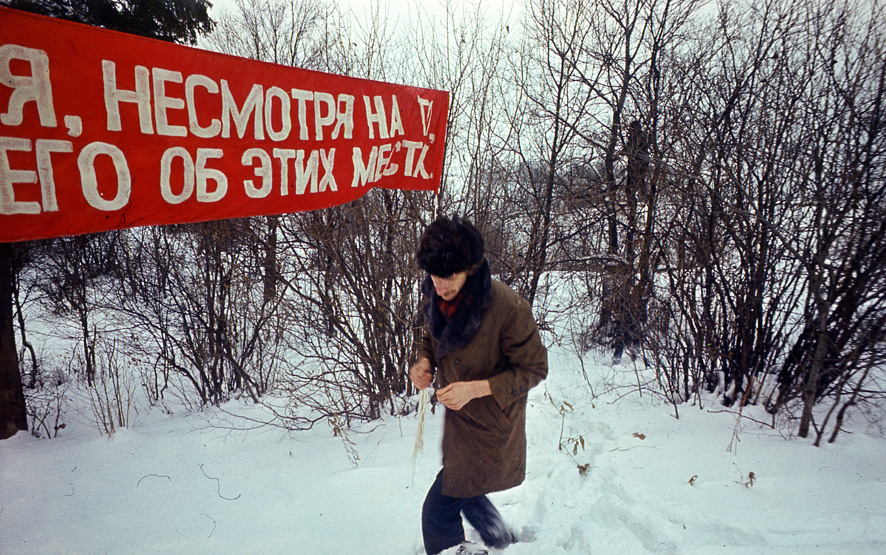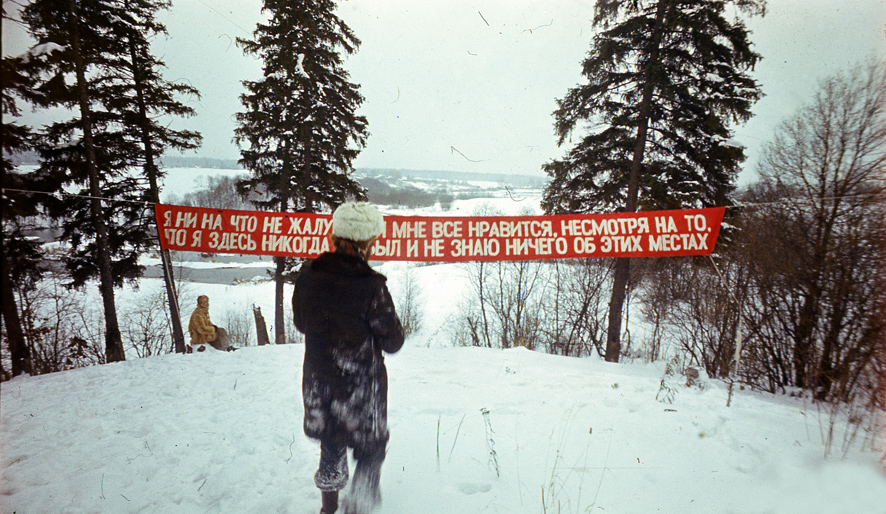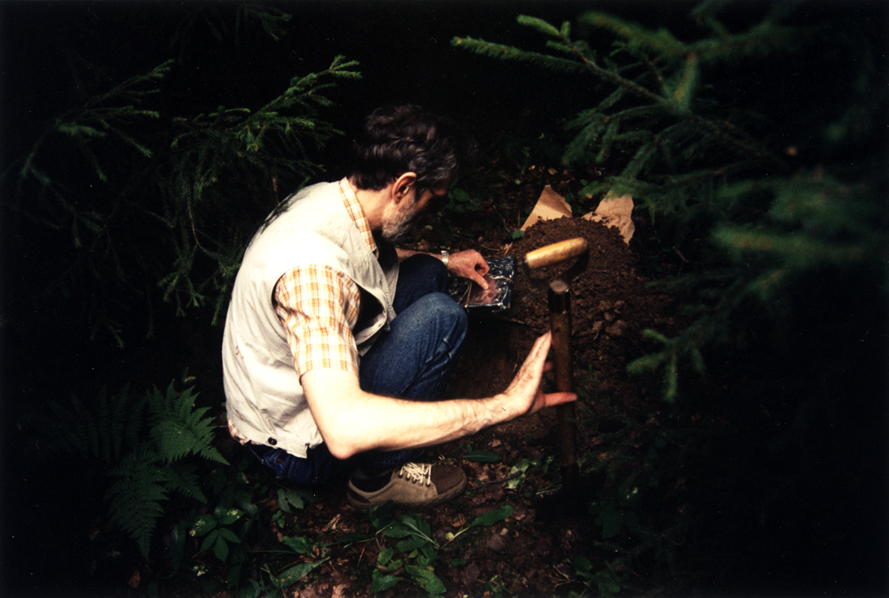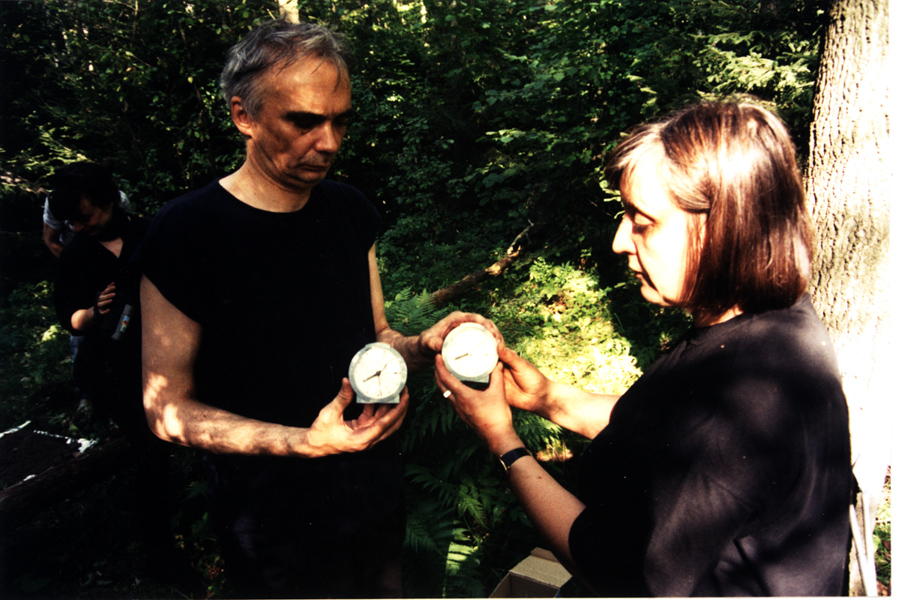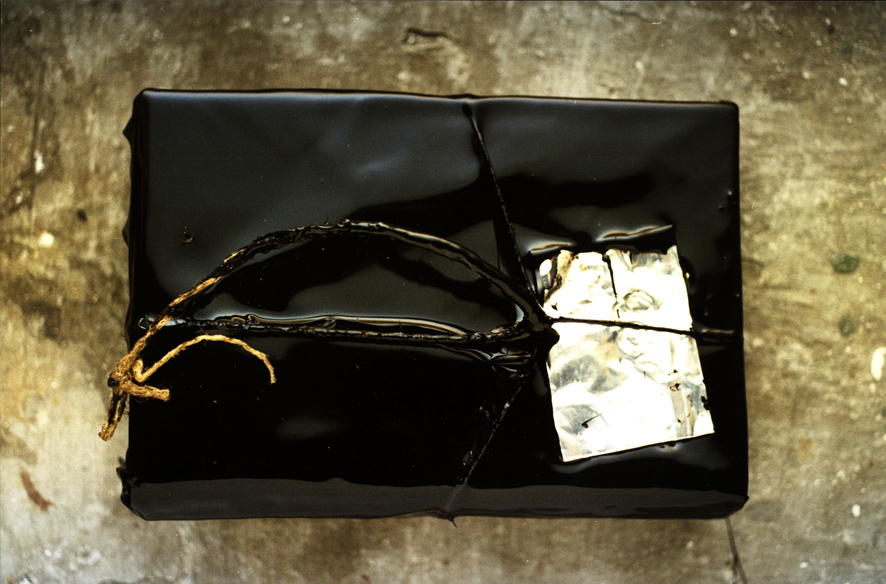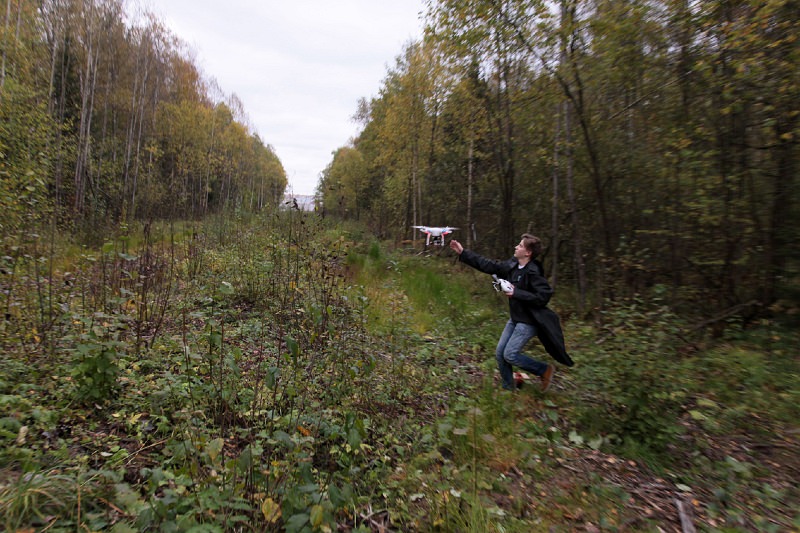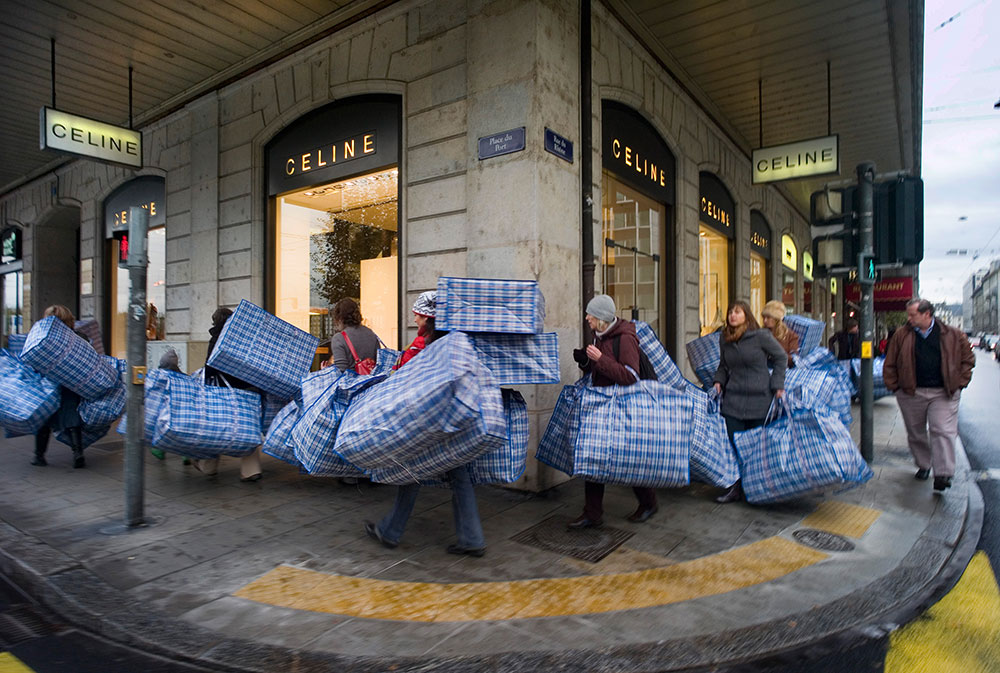Field studies: behind the Soviet-era art collective that continues to defy the norm
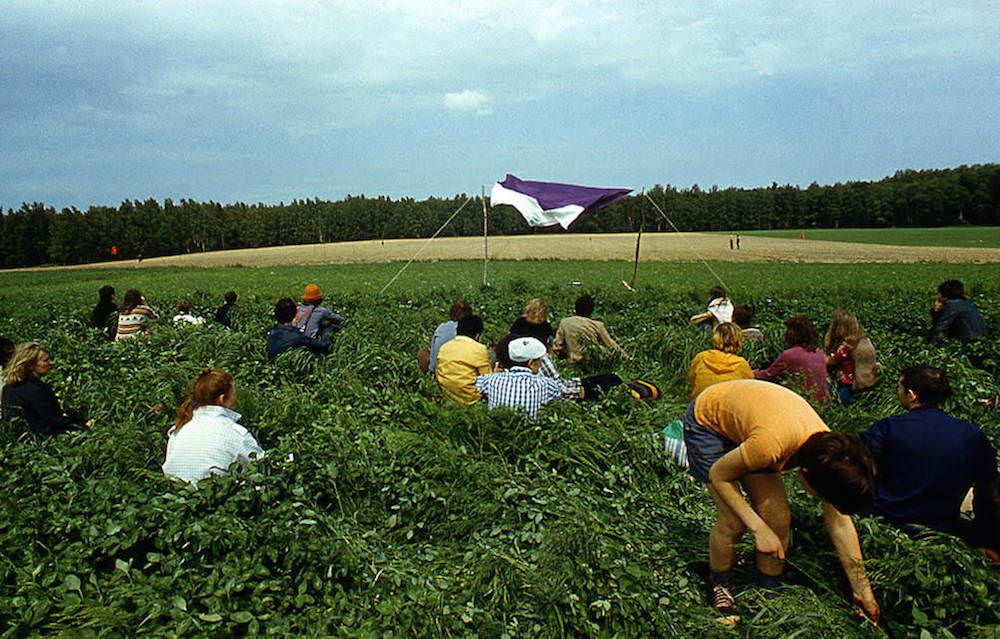
The Collective Actions Group included some of the best known non-conformist artists of the late Soviet period and pioneered conceptualism in Russia. Last month it celebrated its 40th anniversary. With its experiments in the fields outside Moscow, the group continues to explore how we perceive art
Thirty or so people stand on the edge of a large field in anticipation. Some tug their fur hats tighter and huddle together for warmth; others light cigarettes, drawing in the crisp forest air with the tobacco smoke. One man produces a flask from the depths of his coat and takes a swig of strong alcohol, most likely cognac or whisky. Polite conversation gathers momentum, then suddenly breaks off into silence: “It hasn’t begun yet, has it?” Everyone surveys the field. But nothing obvious appears to be happening yet. Eventually, two figures appear from the forest on the far side of the field. They make their way towards the spectators and, upon completing their path across the snow covered plain, hand them a small paper document: a certificate of their attendance at The Appearance.
This event, organised on 13 March 1976 by artists Andrei Monastyrsky, Lev Rubinstein, Nikita Alekseev, and Georgii Kizevalter, marked the birth of Moscow’s Collective Actions Group (CAG). Operating for almost forty years now, CAG can be considered the longest-running collective in the history of art. The participants and spectators have changed over the years. Many renowned Russian artists have taken part (Ilya Kabakov, Dmitri Aleksandrovich Prigov, the writer Vladimir Sorokin among others), while more recent actions have involved a new generation of artists (Andrey Kuzkin, Olga Kroytor and MishMash to name a few). Despite the fact that CAG is something of a tight-knit community — attendance used to be exclusively by personal invitation from the organisers — the group can be seen as a kind of living organism spanning the consciousnesses of all the people to have taken part in one way or another.
“Empty action”, which often drew on the practices of Zen Buddhism, was in fact the main event of any given action; yet at the time it was impossible to say quite what was taking place. Ultimately, the event formed out of participants’ and spectators’ interpretations and the residual “factographical” documents, as CAG termed the records and documentation of the action. These testimonies never fitted neatly together into a singular version of the truth. Documentation of the actions was gradually assembled into thick tomes entitled Journeys out of town. One member of the group, Sergei Sitar, compares these volumes with the logbook of a space ship and the participants themselves with cosmic investigators of the collective conscious and subconscious.
The agenda of erasing the boundary between art and life proved a highly complex “schizoanalytic experiment”, to use the term from CAG’s dictionary: reality was stripped of its usual meanings, consciousness was expanded, and, in spontaneous, sometimes absurd associations, the overheated mind of the artist would find the purest possible insight — a seed from which a whole narrative could later grow. This artistic method, close to applied psychology, has perhaps been CAG’s most significant aesthetic discovery. Indeed, in the early days this proved far from innocuous: Monastyrsky’s ardent experiments with perception led him to real, clinical schizophrenia, which he would later describe in his brilliant novel Kashirskoe Highway.
In the 1990s, when the real Kievogorskoe field began to fill up with dachas, the group was increasingly pushed into outlying areas. Several actions also took place in public spaces in Moscow. Library, which took place on 28 August 1997, marked a shift in CAG’s practice from the meditative investigation of consciousness to the contemplation of time and the age. Participants of the group buried thirty ideological books whose years of publication (between 1976 and 1996) coincided with the years in which CAG had conducted the actions on Kievogorskoe field. The pages of each book included materials from the corresponding actions. Library was the first in a series of CAG actions in which the motif of burial played a central role. These actions were at once memento mori, attempts to make sense of the past, and reflections on the fate of cultural memory. Later, in Underground hibernation in Heidegger’s clearing (2013), books were replaced by a more modern medium: SD cards. The memory cards, which contained videos by CAG members and the spectators of the action, had been pre-packed inside polar-bear-shaped trinket boxes; during the action, they were buried until the following year.
One moment, they are delving into cultural memory and their own archive; the next, they are exploring the inventions and technologies that are transforming today’s world
In the 2000s, CAG used the ancient Chinese text I Ching and images of Bodhisattva, as well as satellite communications, Google Maps, and even drones as part of their actions. It was no accident that the key figure of this period was Martin Heidegger, a philosopher who wrote a great deal about time and the significance of technologies. During the action Slogan-2003, a portrait of the philosopher was hung from the trees in a forest clearing. CAG’s attunement with the times had always characterised group’s practice even if it was not always obvious. Rather than perish with Soviet ideology from which the young founders of the group were seeking emancipation, the group have made time and the replacement of one era by another the subject of their artistic investigation. Thus, CAG have been able to continue their practice without losing their relevance: one moment, they are delving into cultural memory and their own archive; the next, they are exploring the inventions and technologies that are transforming today’s world.
Summa, the last CAG action to date, took place on 2 October 2015. The participants arranged a large purple circle on the ground containing the number 1204, the ordinal number of CAG actions conducted in that place. A drone was then launched and filmed the circle and the participants standing beside it from the air. It was flown by the youngest person present, a boy called Petya, who, with remote control in hand, seemed to be directing everything taking place. In a text recounting the day’s events, the artist Masha Sumnina described the strange change in perception that she had experienced during the action. The video drone excluded the figure of the photographer — everybody present fell within the frame of its mechanical eye; meanwhile, from a height, the differences between people, hillocks, and bushes began to be lost. Watching back the footage, the participants discovered that the sole recorded sound was that of the drone itself, while the camera’s rendering of the reality below was reminiscent of a computer model. The drone refused to ascend beyond 105m, seemingly due to the proximity of Sheremetyevo airfield.
The day before the Summa action was the final day of the 6th Moscow Biennale in the central pavilion of VDNKh. As part of that programme, Andrei Kuzkin had performed Balloons and Nails, a work with a surprising connection to CAG’s actions. The artist positioned himself directly outside the main entrance to the pavilion, sitting on a stool between two boxes: in one were white balloons, in the other, nails. Kuzkin would inflate a balloon and offer it to a spectator. Should that person accept the balloon, he or she was then given a nail. What to do next was up to the recipient. More often than not, the routine concluded a moment later with a small bang.
Of all of the young artists to have participated in CAG’s actions in recent years, Kuzkin is perhaps the best example of why it is too early to consign the collective to the cultural archive. The journeys out of town are still beguiling; they still promise aesthetic revelations and deep contemplation even if you are a remote spectator and the field is confined to your computer screen. The idea for Kuzkin’s Balloons and Nails performance was in fact inspired by the artist’s experience participating in the CAG’s Koschei the Deathless of Collective Actions on 12 February 2015. In Russian folk tales, Koschei the Deathless is an evil wizard whose death is concealed in several magic animals and objects stowed one within another. His death is to be found “on the tip of a needle, the needle in an egg, the egg in a duck, the duck in a hare, the hare in a chest, the chest hanging in chains from an oak”. As part of the action, Kuzkin was supposed to go into the forest and inflate a red balloon. However, as an account by Masha Sumnina relates, the balloon unexpectedly burst.
In her text, just as in all of CAG’s written and non-written documentation, there are countless other details that show how art and life intertwine and how the membrane between them is no less delicate than the rubber membrane of a balloon. Every CAG action is some form of the following riddle: how can a nail and a balloon give rise to the entire myth of Koschei the Deathless? The answer, perhaps, is the one-handed clap of an empty action’s elusive protagonist, even this moment ringing silently out across a snow-clad field.
Making no more than a few performances a year, CAG’s quiet bay of contemplation and reflection is almost unreachable by the waves of political actions raging in the public space in recent years, such as the art performances by Voina, Pussy Riot, and Pyotr Pavlensky. However, CAG’s experience has its own potential. This is the potential of a certain form of life, the “aesthetics of existence”, as Michel Foucault might have put it. CAG did not only follow the modernist idea of art as a life-creating force, but have called into being unprecedented research of aesthetic practices of the self. At the heart of this project we see the person, the subject, investigating the shape and boundaries of his consciousness using the means of art. This experience is always personal, but also universal. As Monastyrsky once stated, “A man spends all his life reading only his book, which no one else has.” It is necessary to take a step further, recalling the words of the Greek philosophers, the Stoics: “Directing a look at themselves, they grasp the whole universe.”
